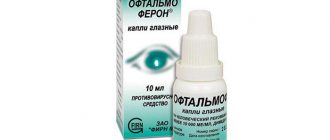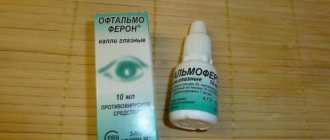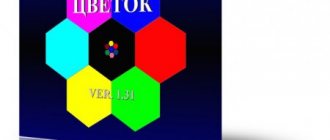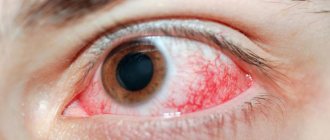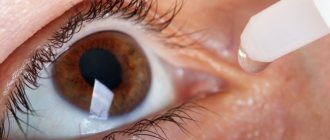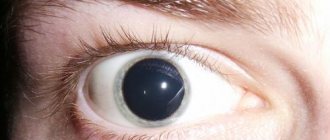Pharmacodynamics and pharmacokinetics
Human recombinant interferon alpha-2b, which is included in Ophthalmoferon eye drops as an active ingredient, is an antiviral immunomodulatory antiproliferative compound. Its action is complemented by an antihistamine - diphenhydramine. The latter blocks H1-histamine receptors, eliminating allergy symptoms by reducing swelling and itching in the conjunctiva.
With topical use of the drug, no manifestations of systemic absorption have been recorded. This is confirmed by clinical blood tests, during which it was revealed that the content of active substances of eye drops in plasma is significantly less than the standard detection limit (for interferon alpha-2b this figure is 1-2 IU per 1 ml). Thus, there are no clinical symptoms of systemic absorption of diphenhydramine and human interferon alfa-2b.
Instructions for use
Instructions for use of Oftalmoferon recommend using drops for any conjunctival eye lesions until symptoms disappear completely. Eye drops are suitable for long-term use because they do not cause tolerance to their constituent components.
Treatment of viral diseases
In the acute stage or at the initial stage of treatment, the drug is instilled into each conjunctival sac 6-8 times a day, 1-2 drops. When positive dynamics appear, the number of instillations is reduced to 2-3 times a day. The use of the medicine continues until the symptoms of the disease are completely eliminated.
Dry eye treatment
In the treatment of dry eye syndrome, Oftalmoferon is prescribed for a long period (from 6 weeks). 2 drops are instilled into each conjunctival sac in the morning and evening.
After surgery
After excimer laser surgery to restore eye refraction, Ophthalmoferon eye drops are prescribed, from the day of the operation, for 6 weeks, 2 drops 3 times a day. The duration of use of the drug after keratoplasty is 2 weeks.
Prevention
As a prophylactic agent, Oftalmoferon is prescribed for 2 weeks. It is necessary to instill 2 drops 2 times a day.
Prescribing eye drops for children
Instructions for the use of Oftalmoferon by children do not differ significantly from the indications for adults. The drug is approved from infancy, since when used topically (instilled into the conjunctival sacs), the minimum concentration of active components is not capable of causing negative reactions. However, before use, you need to contact an ophthalmologist, who will select a treatment regimen and dosage in accordance with the child’s age.
special instructions
Since blurred visual perception may appear immediately after the procedure, it is necessary to refrain from working with dangerous mechanisms and driving a car. Immediately after instilling the drug, the eyes should be rested for at least 20 minutes.
In case of contact correction, contact lenses must be removed before using the medicine. They are allowed to be worn 20 minutes after the procedure.
If 5 days after starting treatment with the drug there is no positive trend, you should consult your doctor. The dosage may need to be adjusted or replaced with a similar drug.
Use in children
There is no age limit for the use of Oftalmoferon eye drops. This is due to the fact that when used topically (instilled into the conjunctiva), the concentration of the active substances of the drug in the bloodstream is so low that there are no side effects.
It is allowed to use the drug in newborns, since it has an antiviral and immunomodulatory effect, and it contains interferon. The drug eliminates itching and promotes the regeneration of damaged eye tissue, effectively coping with the inflammatory process. Before using the drug, it is recommended that the mother consult an ophthalmologist who, depending on the course of the disease and the patient’s age, will select an individual treatment regimen and optimal dosage.
special instructions
People who wear contact lenses must remove them before instilling the product. You can put on the corrective device 20-30 minutes after the instillation procedure. During the course of therapy, it is better to stop wearing contact lenses. Sometimes, after administration of the drug, a veil appears before the eyes. Therefore, after instillation, it is recommended to refrain from driving a car and work that requires concentration for 20-30 minutes. This condition does not require treatment and goes away on its own.
Read more Maxitrol eye drops - how to use
The components of Oftalmoferon do not penetrate into the systemic bloodstream, which makes it possible to use drops for the treatment of pregnant and lactating women. The only contraindication is individual intolerance to the components of the drug. The prescription of an ophthalmic solution does not require cessation of breastfeeding.
These drops can be prescribed to children from birth. Many parents are scared off by the diphenhydramine that is part of the drug. But pediatricians and pediatric ophthalmologists claim that the component will not harm the child if their recommendations are strictly followed. The instructions for use for children indicate a specific dosage. As a rule, the dosage and frequency of use for babies over one year old and newborns are reduced by 2 times.
Only the attending physician, pediatrician, should determine the dosage and duration of therapy. It is strictly forbidden to use the medicine yourself. This is especially true for infants.
A specialist should accurately answer the question at what age Oftalmoferon can be used.
Reviews about Oftalmoferon
According to reviews, the drug is quite effective in treating a number of ophthalmological diseases. Comments regarding the drug are mostly positive, since it can be used in patients of both childhood and old age as an element of therapy for dry eye syndrome, conjunctivitis of various etiologies, as well as for preventive purposes.
Many parents note the safety of using Oftalmoferon for children and the absence of side effects such as itching and allergic reactions.
Drug interactions
It has been proven that Ophthalmoferon eye drops can and should be used together with other anti-inflammatory ophthalmic agents. This combination is used in the development of severe forms of eye diseases. When Oftalmoferon therapy occurs simultaneously with an antibiotic or corticosteroid drug, dosage adjustment will be required. Usually it is reduced.
If Oftalmoferon is prescribed together with other ophthalmic agents (ointments, drops), then the time interval between their use must be observed. It is better to apply eye ointment after instillation after 30-40 minutes.
Read more Maxidex eye drops - instructions for use
When breastfeeding
The lack of studies on the use of drops by women during lactation does not allow us to clearly recommend Oftalmoferon during breastfeeding. As during pregnancy, the drug can be prescribed by a specialist after diagnosis and the presence of acute indications, taking into account an assessment of the risks to the health of the newborn. The insignificant systemic effect of the drug components on the body allows you not to interrupt breastfeeding during the treatment period.
- Zucchini with minced meat in the oven: delicious recipes with photos
- Fish and potatoes in the oven: recipes with photos
- Carp in the oven - recipes with photos. Preparing baked stuffed fish
The nature of the runny nose
Rhinitis is based on inflammation of the nasal mucosa. Swelling is caused by infectious agents: viruses, bacteria, fungi. The cause of allergic rhinitis is the entry into the nasopharynx of substances that provoke the development of swelling of the mucous membrane and copious secretion of mucus.
See also
What is better to take for sore throat in children and adults: “Amoxicillin” or “Amoxiclav”
Read
Causes of nasal congestion include:
- injuries;
- congenital curvature of the nasal septum;
- adenoids with their growth;
- reactions to medications;
- polyps;
- disturbances in the regulation of vascular tone.
A runny nose is a sign not only of colds, but also of autoimmune diseases - psoriasis, rheumatoid arthritis.
Treatment for rhinitis is selected depending on the cause of the disease. Since a runny nose of an infectious nature is more common, antiviral drugs are selected.
Analogs
If the need arises, then it is recommended to replace Oftalmoferon with its analogue. These, if we consider the active component, are medications:
- Altevir;
- Eberon or Reaferon;
- Realdiron or Laifferon;
- Interferal or Alfarona, Intron.
When choosing a similar medicine, you need to understand that it is not covered by the instructions for Oftalmoferon, reviews about it and the price category.
It is important to first obtain the approval of your doctor before attempting to change the prescribed drug yourself.
A solution called Poludan is recognized as a good analogue of Oftalmoferon. Such a medicine, although it does not have full-fledged human interferon, stimulates its independent production by the eye.
Other medications that are similar in therapeutic effect to Oftalmoferon drops are:
- Albucid and Aktipol;
- Floxal and Tobrex.
Let's take a closer look at the characteristics of drugs similar to Oftalmoferon, both those listed earlier and new ones:
- Alfarona. This is a powerful immunomodulatory agent that resists viruses from the interferon group. Since pathology provocateurs quickly develop protection against drugs of this class, long-term use of these drops in therapy is a useless measure. The product has maximum effect when instilled in the first three days.
- Albucid. The medication is most effectively used in the treatment of bacterial conjunctivitis, since the medicine penetrates deep into the eye, after which it stops the spread of pathogenic microflora, destroying it at the cellular level.
- Reaferon-EC. Such drops are recommended for viral attacks on the outer parts of the eyes.
- Poludan. This medicine is comparable to Oftalmoferon in the speed of its penetration into the eye. The basis of the product is polyriboadenylic acid. It is not an active substance that can act directly on pathogenic microorganisms. But this is a powerful stimulant that pushes the immune system to take more decisive action, after which the body independently begins to resist the pathogens of the disease. The ingredients of the medicine are mixed with the eye fluid and then produce a stimulating effect. After this, they are immediately taken outside.
- Aktipol. Such an immunomodulatory drug, characterized by an antiviral effect, has antioxidant properties. The medicine actively helps restore the cornea. Drops also help eliminate swelling, they heal wounds along with ulcerations that occur due to the negative effects of pathogens. It is allowed to use drops as a healing product necessary after mechanical damage to the eye.
- Altevir. These are antiviral drops that quickly stimulate the immune system. Thanks to this, all internal resources are mobilized, starting to confront viral pathogens that provoke ophthalmological pathologies.
Additional Information
When using this product, you must adhere to the following rules:
1. Store an open bottle of drops for no more than thirty days.
2. Keep the drug in a dark place, at a temperature of two to eight degrees Celsius.
3. If a person wears contact vision correction, they should be put on only fifteen minutes after applying the drops.
4. It is recommended to use Ophthalmoferon drops according to indications; it is advisable to first consult a doctor.
The product has a complex effect and is aimed at solving many problems associated with diseases of the organs of vision.
According to doctors, many drugs can be used in conjunction with this medicine. Other agents for relieving inflammation, fighting bacterial infections and having a regenerating effect enhance the effect of Ophthalmoferon. The medicine can be bought at a pharmacy. The average price in Russia varies from two hundred fifty to three hundred rubles.
